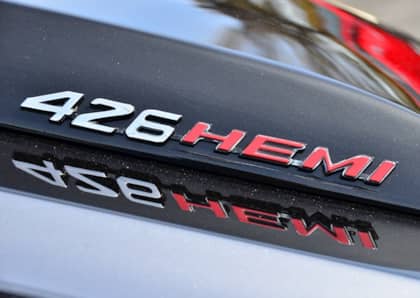The 440 Big Block V8 Was More Than Just Chrysler's Muscle Car Engine
Chrysler's big block engine program was on a roll in the 1960s. Riding on the success of the 383 cubic inch B engine that had debuted in 1959, and supported by the 413 and 426 cubic inch 'wedge' RB engines that dominated street performance during the earliest days of the muscle car era, there was no shortage of major cube options in Plymouth, Dodge, and Chrysler showrooms.

Still, there was another champion waiting in the wings by the middle of that decade—and no, we're not talking about the 426 Hemi. Chrysler's longer-lasting, and nearly as potent 440 V8 not only set the drag strip on fire, but it lived on well after the muscle era's embers had died out, powering sedans, coupes, pickups, and even motorhomes until the advent of the 1980s.
Building On A Firm Foundation
The origins of the Mopar 440 are easy to trace. The 383 cubic inch engine was a stout performer, with 330 horses on tap and 460 lb-ft of torque right from its debut. The main advantage of the larger bore B design was its less-complicated head design, which was lighter and cheaper to build than Chrysler's early hemi while producing more power. Chrysler then raised the height of the B block (hence the 'RB' or 'raised block' designation) to create its high performance 'wedge' motors (named, like the hemi, after the shape of their combustion chambers).

The 440 took the 413 cubic inch wedge's fundamentals and bored it out for extra displacement, The 440 was the final evolution of the RB design that had given birth to the earlier 'wedge' engines, and its massive size gave it much more torque than its predecessors (roughly 480 lb-ft).

Although not as exotic or as rare as the 426 cubic inch Hemi engine, the 440 was a force to be reckoned with. Much less expensive to purchase and easier to keep in tune, horsepower was advertised at 375 ponies for the 'Magnum and 'Super Commando' high performance engines found in Dodge and Plymouth models, with the 'Six-Pack' triple carb setup adding another 15 horses and 10 lb-ft of twist.

The 440 first appeared in 1966, and before long it was available in both full-size sedans and coupes as well as the intermediate muscle machines that were entering their glory years. It was even borrowed by a number of European sports and grand touring cars (like the Jensen Interceptor and the Iso Grifo). It wasn't long, however, before EPA smog restrictions and corporate concerns over fuel mileage would shut down the high compression designs featured by the original Chrysler 440 engine and transition it to its second act.
Moving Into The '70s
In 1972 the move to 'net' from 'gross' horsepower ratings hobbled the big block Mopar on paper, dropping output to 225hp and 345 lb-ft of torque for base models, with the tri-carb setup showing 330 horses and 410 lb-ft of twist. A 'high performance' version of the engine split the difference with a 280/375 rating.

Also contributing to the lower numbers? Lower engine compression and an iron crankshaft instead of the forged steel unit that had been found in the earlier muscle cars, a move that added so much weight that external balancing suddenly became necessary.

Still, the 440 soldiered forward in much the same way that Ford and GM's big block engines did in the 1970s: as torque monsters suited for hauling ultra-heavy full-size cars, bulky police sedans, and trailer-laden trucks and SUVs. RV builders like Winnebago also frequently tapped the Dodge 440 and the truck chassis that it was installed in for use in building the motorhomes that surged in popularity that decade.

In 1977, Chrysler made a decision that would help seal the 440's fate. The previous year it had unveiled the 'Lean Burn' emissions control system, which was intended to provide primitive electronic controls over ignition systems on its 400 cubic inch V8, and this technology eventually spread to all V8 engines, including the 440.

Unlike its original implementation, the '77 cars required a catalytic converter in addition to the janky 'Lean Burn' tech, which wasn't very good at adjusting timing and spark to 'clean up' emissions internally using the most basic of sensor data for a complex, vacuum-dependent carbureted engine. Although fuel mileage was decent when the system was in-spec, it proved unreliable in real world driving as its computer controls couldn't handle the heat and vibration of the engine bay.

By 1978, Chrysler was in dire straits financially, and couldn't justify the continued production of the 440 with or without a set of finicky electronic nannies in the mix. The engine left production as the automaker frantically fought off insolvency, eventually emerging from bankruptcy protection just a few years later with no more big block V8 on the order sheet to counter its Detroit rivals.
A Mopar Mainstay
The Mopar 440 engine remains a very popular choice for modern project cars. As a big block, it's cheap and plentiful to find used or in a salvage yard and the RB family has a strong aftermarket and strong community of experienced builders helping to support it.

Even engines that hail from the low-compression mid-70s can be brought back to life with fresh pistons, better flowing heads, and one of many aggressive camshaft choices that will add serious horsepower to their strong torque numbers. For less than half the cost of a crate motor, and far less than a comparable 426 Hemi, a rebuilt 440 is a well-tested ticket to major thrills in a long list of Dodge, Chrysler, and Plymouth platforms.
More From Driving Line
- Want to learn more about the Max Wedge, Chrysler's 'other' 426 cubic inch V8? We dive deep into the history of this mighty big block.











